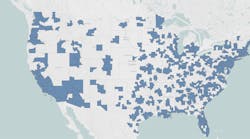Distributors, independent manufacturers’ reps and electrical manufacturers serving NAED’s mammoth Western Region have plenty of reasons to be cheerful going into 2018, particularly those companies focused on the construction market.
NAED’s Western Region touches more than 20 states and includes some of the nation’s fastest-growing markets, and some of the areas of the country seeing the most population growth and increases in construction employment. Over the past few years, many of the region’s largest cities have outpaced the construction market growth of most other metropolitan areas in the entire United States. These cities include Austin, Dallas, Houston, San Antonio and Midland-Odessa, TX; Phoenix, AZ; Los Angeles, San Diego, Riverside County and San Francisco, CA; Las Vegas, NV; Seattle, WA; Boise, ID; Salt Lake City, UT; and Denver, CO.
The chart on page 2 lists the NAED Western cities with electrical contractors hiring employees at twice the national rate through November, when measured by percent change year-over-year (YOY) (roughly + 3.2%). Topping the list were several metros that saw electrical contractor employment increases of over 10% — Las Vegas (+18.1%); Riverside-San Bernardino-Ontario (+17.2%); Killeen-Temple, TX (+15.2%); and Portland-Vancouver-Hillsboro, OR-WA (+13.2%).
Over the past few years, Electrical Marketing has made note of many of the construction projects in the $100 million-plus range that broke ground over the past few years in these markets, but there’s plenty more construction business on the way. The projects include two new data centers in Prineville, OR, a town that already saw $1 billion in construction from its three existing data centers; a plan by Google to build up to 10,000 affordably priced housing units and additional office space and shops near its Silicon Valley campus; the recently started $1.5 billion, 12.3-mile light-rail line extension in Los Angeles; Denver’s billion-dollar National Western Center project for livestock shows and other agricultural events scheduled to break ground this year; plans for a 15,000-seat arena and 40,000 outdoor stadium in Austin; and a massive waterpark in the north Houston suburb of New Caney, TX, that includes four hotels and 450,000 square feet of retail and dining that recently broke ground.
In addition to these projects, several sports arenas are either already underway or in the planning stages, including a new stadium for the Golden State Warriors in San Francisco; new stadiums for the NFL’s Oakland Raiders in Las Vegas; a new baseball stadium for the Texas Rangers, and a stadium for the NFL’s Rams and Chargers in Los Angeles.
The region’s industrial market hasn’t seen as much growth as the construction market, but it includes large swaths of the biggest oil patches in the country. When oil & gas is booming in Texas’ Permian and Eagle-Ford basins (as it is now), Oklahoma, Alaska, and North Dakota’s Bakken region, the energy dollars spill over into the many ancillary industrial markets, too. According to the Alaska Oil & Gas Association, one-third of the state’s jobs are tied to the energy industry. The state’s economy has been hurt by the drop in oil prices, but the 3Q 2017 manufacturing employment data that contains oil & gas employment is showing some improvement.









